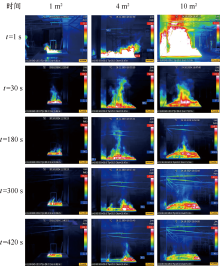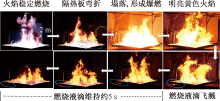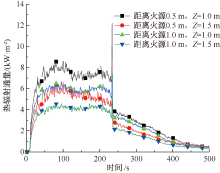| [1] |
张小虎. 白酒厂类火灾高危单位消防安全评估及应用[J]. 安全与环境学报, 2017, 17(3):879-882.
|
|
ZHANG Xiaohu. On the fire-risk safety evaluation and its application in the hard-liquor factories[J]. Journal of Safety and Environment, 2017, 17(3):879-882.
|
| [2] |
LI Xueming, WAN Wei, ZHAO Youkai, et al. Feasibility assessment of a clean and efficient fire extinguishing system for pottery jar liquor warehouses[J]. Scientific Reports, 2024,14: DOI: 10.1038/s41598-024-64168-4.
|
| [3] |
王晨阳, 万景明, 王晨, 等. 不同液面高度陶坛火燃烧行为及破裂规律试验研究[J]. 消防科学与技术, 2025, 44(3):320-328.
|
|
WANG Chenyang, WAN Jingming, WANG Chen, et al. Experimental study on combustion characteristics and fracture rules of pottery jar with different liquid level[J]. Fire Science and Technology, 2025, 44(3):320-328.
|
| [4] |
毕远林, 钟航, 黄蓝花, 等. 白酒贮存工艺研究进展[J]. 酿酒科技, 2022 (12):80-84.
|
|
BI Yuanlin, ZHONG Hang, HUANG Lanhua, et al. Research progress in Baijiu storage technology[J]. Liquor-Making Science and Technology, 2022 (12):80-84.
|
| [5] |
孙玉佳. 基于大涡模拟的油池火焰瞬态辐射传热研究[J]. 中国安全科学学报, 2022, 32(4):65-71.
doi: 10.16265/j.cnki.issn1003-3033.2022.04.010
|
|
SUN Yujia. Transient radiative heat transfer of pool fires based on large eddy simulation[J]. China Safety Science Journal, 2022, 32(4): 65-71.
doi: 10.16265/j.cnki.issn1003-3033.2022.04.010
|
| [6] |
杨小松, 杨再华, 王元波, 等. 环形池火炙烤情形下陶坛破裂特性研究[J]. 消防科学与技术, 2025, 44(2):202-209.
|
|
YANG Xiaosong, YANG Zaihua, WANG Yuanbo, et al. A study on the rupture characteristics of ceramic jar under conditions of heating in circular oil pool fire[J]. Fire Science and Technology, 2025, 44(2):202-209.
|
| [7] |
HAKKARAINEN T, KORHONEN T, VAARI J. Heat release characteristics of ethanol-water mixtures: small-scale experiments[J]. Fire Safety Journal, 2017,91:174-181.
|
| [8] |
张笑驰, 刘家豪, 谢启苗. 小尺寸乙醇-水混合溶液池火燃烧特性研究[J]. 消防科学与技术, 2019, 38(11):1502-1505.
|
|
ZHANG Xiaochi, LIU Jiahao, XIE Qimiao. Study on combustion characteristics of small-scale ethanol-water mixtures pool fire[J]. Fire Science and Technology, 2019, 38(11):1502-1505.
|
| [9] |
CHEN Qinpei, WANG Xuehui, ZHOU Tiannian, et al. Investigation on the fire hazard characteristics of ethanol-water mixture and Chinese liquor by a cone calorimeter[J]. Journal of Thermal Analysis and Calorimetry, 2019,135:2297-2308.
|
| [10] |
赵利宏, 张清元, 王晓天, 等. 高原乙醇油池火燃烧特性实验研究[J]. 中国安全生产科学技术, 2022, 18(5):66-71.
|
|
ZHAO Lihong, ZHANG Qingyuan, WANG Xiaotian, et al. Experimental study on burning characteristics of ethanol pool fire in plateau[J] Journal of Safety Science and Technology in China, 2022, 18(5):66-71.
|
| [11] |
郝苗, 赵炬, 李梦函, 等. 含水乙醇表面火蔓延及燃烧特性研究[J]. 科技创新与应用, 2023, 13(18):57-65.
|
| [12] |
郝苗, 孙得盛. 含水乙醇溶液火灾危险性影响研究[J]. 科学技术创新, 2023(4):31-36.
|
| [13] |
张军, 方俊, 王静舞, 等. 近墙乙醇池火热反馈对燃烧速率的影响[J]. 安全与环境学报, 2014, 14(5):85-89.
|
|
ZHANG Jun, FANG Jun, WANG Jingwu, et al. Effect of heat feedback on the fire-burning rate of ethanol pool fire close to the wall[J]. Journal of Safety and Environment, 2014, 14(5):85-89.
|
| [14] |
翟东, 章光, 何明礼. 半敞开式白酒库泄漏事故火灾风险分析[J]. 消防科学与技术, 2020, 39(1):58-66.
|
|
ZHAI Dong, ZHANG Guang, HE Mingli. Fire risk analysis of leakage accident in semi-open liquor depot[J]. Fire Science and Technology, 2020, 39(1):58-66.
|
| [15] |
张培红, 郝宇军, 李子建. 环境湿度影响受限空间池火的实验[J]. 东北大学学报:自然科学版, 2019, 40(9):1355-1359.
|
|
ZHANG Peihong, HAO Yujun, LI Zijian. Experiment on the effect of environmental humidity on the pool fire in confined space[J]. Journal of Northeastern University: Natural Science, 2019, 40(9):1355-1359.
|
| [16] |
GB 4716—2024,点型感温火灾探测器[S].
|
|
GB 4716-2024, Point type heat fire detectors[S].
|
| [17] |
GB 50116—2013,火灾自动报警系统设计规范[S].
|
|
GB 50116-2013, Code for design of automatic fire alarm system[S].
|
| [18] |
冯娇娇, 王静虹, 李佳, 等. 火灾事故下人群承受热辐射阈值差异分析[J]. 中国安全科学学报, 2020, 30(10):134-140.
doi: 10.16265/j.cnki.issn 1003-3033.2020.10.019
|
|
FENG Jiaojiao, WANG Jinghong, LI Jia, et al. Difference in the thermal radiation threshold of people under fire accidents[J]. China Safety Science Journal, 2022, 30(10):134-140.
|
| [19] |
赵志新, 蔡炜, 王鑫, 等. 热辐射强度对棉花燃烧特性的影响[J]. 消防科学与技术, 2020, 39(2):167-170.
|
|
ZHAO Zhixin, CAI Wei, WANG Xin, et al. Influence of heat radiation intensity on the combustion characteristics of cotton[J]. Fire Science and Technology, 2020, 39(2):167-170.
|
| [20] |
付丽华, 张瑞芳, 石龙. 基于锥形量热仪实验的卷烟及其包装材料燃烧特性研究[J]. 火灾科学, 2009, 18(1):20-25.
|
|
FU Lihua, ZHANG Ruifang, SHI Long. Experimental research on fire behavior of cigarettes and its packing materials using cone calorimeter[J]. 火灾科学, 2009, 18(1):20-25.
|
| [21] |
黎昌海, 吴迎春, 陆守香, 等. 封闭空间油池火火焰振荡特性研究[J]. 中国科学技术大学学报, 2010, 40(4):380-386.
|
|
LI Changhai, WU Yingchun, LU Shouxia, et al. Study on flame pulsation of pool fires in closed compartments[J]. Journal of University of Science and Technology of China, 2010, 40(4):380-386.
|

























